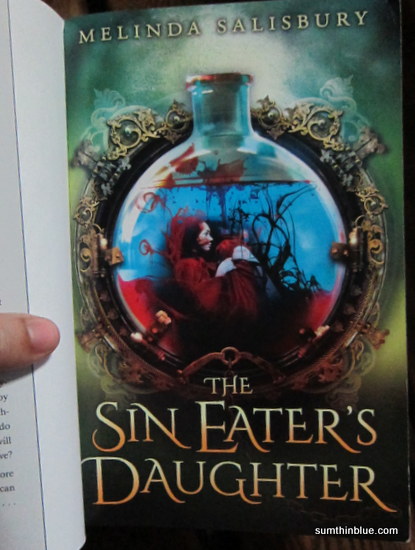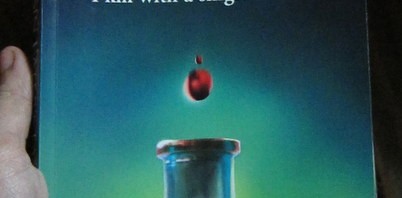 Here’s another new release I just finished reading: The Sin-Eater’s Daughter by Melinda Salisbury.
Here’s another new release I just finished reading: The Sin-Eater’s Daughter by Melinda Salisbury.
The first book in a new series, this novel is a medieval fantasy set in the kingdom of Lormere, where seventeen year-old Twylla is the executioner. The daughter of a Sin-Eater (a villager who performs the ritual meal that will absolve the dead of their sins), Twylla was taken away at a young age to live at the palace as the embodiment of Daunen, the daughter of the gods Daeg and Naeht, and the betrothed of crown prince Merek.
As Daunen Embodied, Twylla has the special ability to kill with a single touch, which is wrought upon those charged with treason. Apart from her duties as executioner, she lives life in isolation as the entire court is careful not to come into contact with her. But when a new guard, Lief, is assigned to protect her, Twylla’s life is turned upside down, and the world she knows will never be the same again.
 I enjoyed the novel mainly for its lore. After a bit of googling, I learned that sin-eating is a ritual that has been practiced across different civilizations across the world, and I like how this book builds on this tradition and gives it a whole new dimension.
I enjoyed the novel mainly for its lore. After a bit of googling, I learned that sin-eating is a ritual that has been practiced across different civilizations across the world, and I like how this book builds on this tradition and gives it a whole new dimension.
“My supper remains untouched, the grease congealing on the stewed meat doing nothing to tempt me to eat. My old life with my mother loaded certain foods with meaning and though I know the difference between eating and Eating, I cannot help but silently measure the morsels when it’s food I remember from an Eating. Most of the food I eat here is castle food — the queen would never eat what the commoners eat — but now and then something comes along that I know of old. A heel of seeded bread is a lie; a wedge of hard cheese is a debt left unpaid. Stewed meat is for obstinacy, and I wonder if the queen had sent it deliberately.”
Twylla’s recollections about her mother’s practice is the most interesting part of this book: sins symbolized by a certain type of food, the sin-eater refusing to ‘eat’ certain types of sins, ritual offerings to restore the balance, and other details that paint a vivid picture of this funeral rite for the reader. It’s fascinating stuff, sin-eating.
(That said, the title is a bit off, because the novel isn’t actually about sin-eating. Other than the fact that Twylla was supposed to inherit this role from her mother before she became Daunen, the fact that she is the Sin-Eater’s daughter is not central to the story).
The sin-eating is tied into mythology unique to the book: Lormere’s ancient gods Daeg (Lord of the Sun) and Naeht (Empress of Darkness) and Daunen, their offspring, whose existence strikes the balance between day and night, life and death.
As a prelude to future events, the novel also gives us a peek into the neighboring kingdoms, which further enrich the lore. The rival kingdom of Tregellan has science and alchemy, while Tallith seems to be something out of a fairy tale, with its own moldering palace, sleeping prince and a rat catcher with a magical pipe. Things are bound to get more interesting down the line.
The plot meanders for quite a bit then picks up towards the second half of the novel as the forces in play start revealing themselves, but characters aren’t as fleshed out as I want them to be so the impact of the book is lessened on the whole.
Twylla is somewhat of a frustration to me because I felt there was a missed opportunity for her character to develop. The entire novel is narrated from her point of view (and I realize I’m really not a fan of present-tense) and it’s not a very happy one, and that should have been okay, but with I would have preferred a thread of hope or a sense of empowerment in her voice. She resents her role as the executioner and yearns for freedom but does not do anything about it, and later on, when the story builds up to what would have been a pivotal moment, she’s still a little lost when I felt she should have had the impetus to fight.
There is a love triangle brewing in this fantasy series but at this point it’s a little difficult to choose sides. What we know of both love interests — Merek and Lief — are limited to Twylla’s interaction with them, which makes their motivations hazy at best. A little more insight on their character would have made them more distinct in my memory and perhaps then (maybe it’s Twylla’s dilemma, too?) I could have rooted for one of them.
Even the character of Queen Helewys (who reminds me of Cersei Lannister, incest and all): elaborate schemer, consummate liar, and well, plain diabolically evil — easily the most interesting character in this novel — could have benefited from being less one-dimensional.
The resolution is left hanging in the balance, which makes it difficult to view this book on its own merit as there seems to be a whole lot dependent on future installments. There is a lot more to mine in this series, and there’s plenty to build on for a truly compelling story, so I do hope the next books fill in the blanks.
***
Sin-Eater’s Daughter, ARC (provided by Scholastic), 3/5 stars

